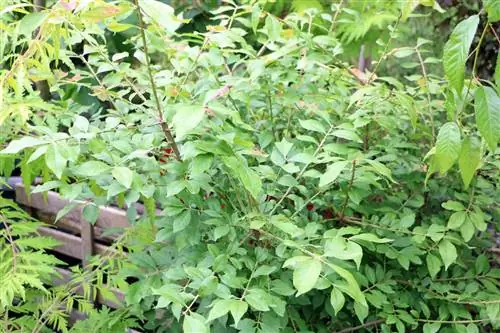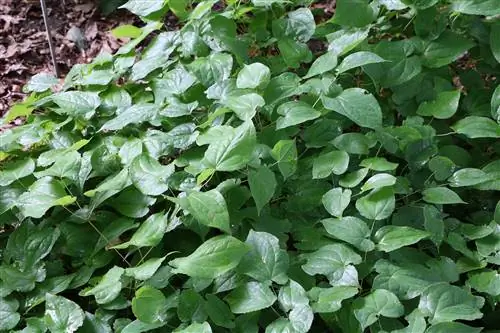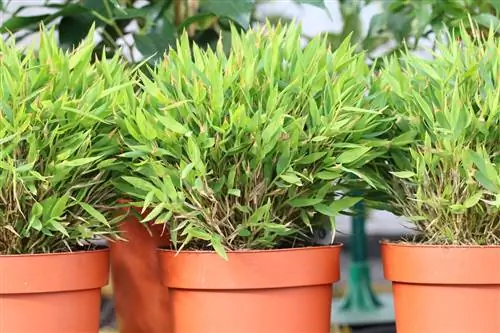- Author admin [email protected].
- Public 2023-12-17 03:39.
- Last modified 2025-01-24 12:45.
Pfaffenhütchen thrive magnificently with lots of flowers if they receive ideal care. Find out more about the plant in the profile and find out everything you need to know about the care measures.
Profile
- scientific name: Euonymus
- Family: Spindle tree family (Celastraceae)
- Growth height: about three meters; some varieties as trees up to six meters
- Flowers: white-green; from May to June
- Fruits: pink to red; from September to October
- decorative autumn colors
- summergreen
- hardy
- highly toxic
Location
The Pfaffenhütchen doesn't make any great demands when it comes to the perfect location. The spindle bush is very tolerant, especially when it comes to the light it requires. If the location meets the following characteristics, nothing stands in the way of he althy growth and lush flowering:
- Light conditions: between full sun and partial shade; reduced number of flowers in full shade
- warm, wind-protected environment
- sufficient space for growth heights of up to six meters and crown width between 1.5 and two meters
- out of the reach of children and pets aspoisonous
Floor
Theoretically, a euonymus will thrive in any type of soil. If you want the best soil conditions for new or transplanting plants, pay attention to:
- looseness
- nutrient- and humus-rich soil
- calcareous soil; the more lime the better
- Do not plant in heavy clay soil as there is a high risk of waterlogging
- dry to moist, but no waterlogging
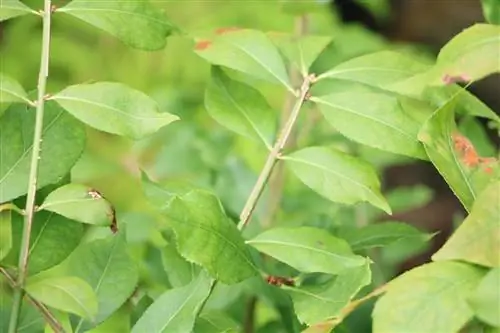
Plants
Once the right location has been found, planting can begin. Proceed as follows:
- Loosen the soil over a large area before planting
- Planting hole size: width and depth 1.5 to twice as large as root circumference/ball
- Lay drainage made of gravel or other suitable material on the ground
- mix the excavated soil generously with humus
- Add in sand for heavier soils
- When planting hedges, maintain a planting distance of around 50 centimeters
- Insert the plant, fill up with soil and press only lightly (otherwise risk of root damage)
- water generously and keep the soil evenly moist in the following weeks
Best planting time
Parish hats can be planted all year round as long as there is no ground frost. However, the best time to plant bare-root specimens is spring. This is where the growing season begins, which stimulates root formation and accelerates solid growth. Ball plants are also best planted in spring, but also in autumn. When planting in autumn, care should be taken to ensure that the first frost is still some distance away. This means that the beginning/mid-October is usually the latest planting time in autumn.
pot planting
The spindle bush can also be easily cultivated in a bucket on the terrace or balcony. There are a few points to consider when planting:
- Bucket size: because shallow roots are at least three times the size of the root circumference
- Drainage hole in the bottom of the bucket so that excess water can drain away
- Substrate: high-quality product that has the same properties as described under “Soil”
- Substrate with perlite ideal for better permeability
Plant Neighbors
All species that can cope with calcareous, acidic to slightly alkaline soil and do not stand in the way of the Pfaffenhütchen's high nutrient requirements are suitable as plant neighbors. These are for example:
- Asters (Aster)
- Fuchsias (Fuchsia)
- Alfalfa (Medicago sativa)
- Pipe grass (Molinia)
- Monkshood (Aconite)
- Delphinium (Delphinium)
Tip:
You should avoid direct plant neighbors that are shallow-rooted. These include numerous perennials and bulbous plants, which would be displaced by the fine root system, which usually spreads along the surface of the earth.
Pouring
All varieties of Pfaffenkäppchen cope equally well with drought and continuous moisture. The only important thing is that no waterlogging occurs, which can lead to death. You can't go wrong if watering needs are determined using the thumb sample:
- Thumb can be pressedlightlytwo or more centimeters into the soil surface:do not water
- Thumb can be pushednotmore than two centimeters into the earth's surface:watering
Tip:
You can have a certain influence on growth by watering. Allowing the soil to dry more often promotes flower formation, while moist soil promotes faster growth.
Fertilize
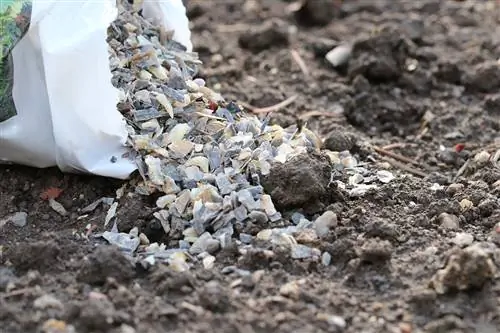
Due to the relatively high nutrient and humus requirements, regular fertilization is necessary. However, this only begins in the second year of planting, because with new plantings and transplants the soil still benefits from the added substances and over-fertilization could otherwise occur. Optimal fertilization works like this:
- Between April and July: Apply organic fertilizer twice a month
- Incorporate compost or humus in spring and autumn
- Hand out a few handfuls of horn shavings in the fall
Cutting
Cutting is not absolutely necessary with the Pfaffenhütchen. However, it should be shortened occasionally so that the shrub retains its shape and does not fall apart in width. Cutting also strengthens growth and gives new energy after diseases or severe pest infestations. The optimal cut looks like this:
- thinning once a year in spring or autumn
- If flowers decline, shorten shoots by a maximum of half
- To correct the height and width in autumn, cut off shoots that are too long close to the ground
- In the case of severe thinning and/or illness/pest infestation, radical cutting is also possible
- Radical cut: cut down to 30 centimeters
- Always choose dry weather for cutting (reduces the risk of infection)
Note:
All parts of a Pfaffenhütchen plant are poisonous and can cause symptoms of poisoning in people and animals if consumed - especially the seeds. If these enter the organism, serious kidney and liver damage and, in the worst case, death can occur. Due to the toxicity, appropriate care precautions should be taken, especially when cutting and care during seed formation.
Wintering
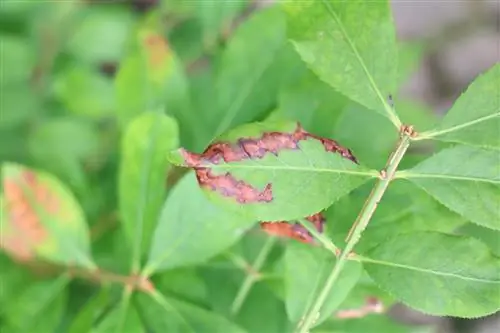
The Pfaffenhütchen is considered very hardy. If it is planted in the garden bed, no additional measures need to be taken to overwinter it outdoors. The situation is different when cultivated in containers, because here the fine roots are significantly more exposed to the cold. Some measures should be taken from November at the latest:
- place sheltered from the wind
- place insulating protection between the bottom of the bucket and the surface (e.g. Styrofoam or wooden panels)
- Cover the soil surface thickly with straw, leaves, mulch, pine needles or brushwood
Propagation
There are various methods to choose from for propagation:
Sowing
Seeds are required for sowing, which can be collected from the capsule fruits either from specialist retailers or from an existing spindle bush. This propagation variant does not have a high chance of success. If you still want to try it, you should do this:
- Collect capsules before they burst
- store dry
- Remove seeds from meat coat after capsule opens in autumn
- Sow seeds immediately in the bed or, if sowing in spring, store them in a sand-filled, sealed container in a cool and dark place
- Distribute seeds uncovered on soil (light germinator)
- first cotyledons often only visible after months
Propagation of cuttings
Propagation through cuttings is a very promising option:
- separate ten to 15 centimeter long shoots in spring
- Remove flowers and/or fruit bases
- Cut leaves in half to minimize water evaporation
- Place the cutting in a glass of water or stick it in continuously moist potting soil
- Root formation approximately after three months
- plant in normal substrate or garden soil after new leaves have formed
- Provide protection from the cold in the first winter
Saplings/root runners
In addition to propagating cuttings, the use of shoots or root runners is also highly recommended. These can be found in the ground area when they protrude from the soil as new shoots or spread over it. Since these come directly from the main root, the separation must be carried out here. The sapling should then be placed in the soil with the interface and kept evenly moist for the next few weeks. As with cuttings, the first wintering must be done with protection from the cold.
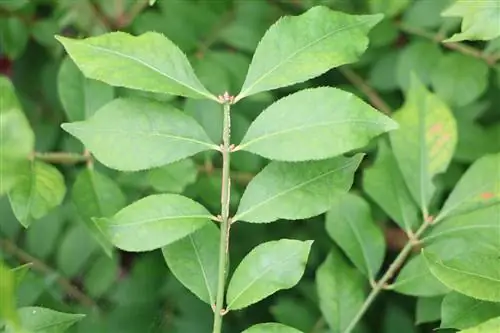
Diseases
Pfaffenhütchen are considered susceptible to powdery mildew and downy mildew. These are fungal infections that are usually easy to get under control.
Powdery mildew
- Mix raw or whole milk with water in a ratio of 1:8
- fill into spray container and spray plant until dripping wet
- Duration and frequency of use: every two days in the following two weeks
Downy mildew
- chop four cloves of garlic
- Alternative: a medium-sized onion
- pour a liter of boiling water over it
- After cooling, sieve out the garlic or onions
- Pour the broth into a spray container and spray parts of the plant while they are dripping wet (especially the undersides of the leaves)
- Duration and frequency of use: every two days in the following two weeks
Pests
Pfaffenhütchen's web moth (Yponomeuta cagnagella)
The euonymus bush is primarily attacked by the web moth. The butterflies lay their eggs on them and the offspring cause the damage during the caterpillar's development stage. The caterpillars and butterflies can be recognized by their typical features/characteristics:
- Caterpillars: light brown body color and yellow-brown head; form fine, white web threads mainly between stems and leaves
- Moth: one centimeter tall; white head with white appendages; Wingspan between 18 and 24 millimeters; Wings with black dots
- Damage: Leaf damage down to leaf veins
Fighting the web moth
Although an infestation with spider moths does not usually pose a life-threatening danger to adult snails, combating them still makes sense due to the unsightly loss of leaves. The easiest way to achieve this is to cut out infected shoots and twigs.
Note:
The caterpillars of the Pfaffenhütchen web moth are easily confused with those of the oak processionary moth. In contrast to these, however, they are absolutely harmless to humans.

